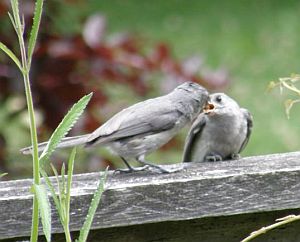 (Something other than peregrines!)
(Something other than peregrines!)
Baby birds are everywhere. The number of fledglings has exploded since the middle of June and they beg so loudly that I hear them before I see them.
In a recent walk through Schenley Park I came across three separate families of tufted titmice – parents and fledglings. At first I expected to see chickadees because the youngsters made a sound similar to the chickadee’s call note. This must be because titmice are related to chickadees.
Like all baby birds, the titmouse babies called and fluttered their wings to attract their parents’ attention. This display could also attract the attention of predators but it certainly made their demands known. The adult titmice were run pretty ragged.
With babies on the wing, the adults look for an easy source of food. If you have a bird feeder they’ll use it immediately with children in tow. That’s how Marcy Cunkelman captured this photo of a tufted titmouse feeding its baby.
While at the feeder the parents eat too. Eventually the youngsters get the hint and look down at the seeds at their feet. “Aha! It’s faster if I feed myself!”
“At last!” think the adults. “We thought you’d never get it.”
I have been seeing lots of baby grackles and robins.
You know what’s amusing — lots of times the babies are bigger than the parents! My young grackles are brownish in color, and bigger than the black parent. They follow the poor parent around mercilessly. I’d want to say, “get it yourself, you lazy thing.” It’s somewhat like the behavior of teenagers/young adults.
On my way in to work this morning I saw a fledgling sparrow nagging one of its parents for food; the poor adult bird couldn’t quite get its offspring to grasp that the piece of bread was right there on the sidewalk if it wanted some.
I was wondering if you could shine some light on a behavior I saw yesterday. I have a large yard which is surrounded by woods on two sides. For the first time ever, a mother turkey was spotted with her babies in tow in the yard a few weeks ago. I, unfortunately, missed that experience. However, there have been recent sightings of what appears to be older versions of the babies in the vacinity of our feeders, aparently on their own already. It’s hard to tell for sure. Yesterday, one was spotted again – right outside the front door – along with a much smaller one “cheep cheep cheeping” away. We lost track of it, but when I looked out towards the back of the house, I spotted the little one (another one? not sure how the first one would’ve gotten back there without us seeing it, although the cheeping out front had stopped). It looked much like a hen chick, but more a mottled brown and yellow. Then one of the larger ones appeared next to it, out from under a hosta. The larger ones are hardly large themselves, but bigger than a blue jay. The little one happily followed the larger one, so I started to doubt if it was actually baby turkeys. I started to wonder if it was another type of fowl. Nothing I looked up seemed to quite match, and the more pictures of juvenile turkeys I saw, the more I thought the original turkey idea matched. I saw the larger one again today, and got a good look through binoculars. It has to be a turkey. My question is, though, why would a much younger chick – newly hatched in appearance – be following an older juvenile? I watched the pair walk through the yard until I could see them no longer and I never did see the adult female. The older one does seem to be independent of mom at this point. Either that, or mom has been quite elusive. Have you ever heard of anything like this? I know in some species, like crows, young adults will help out the parents with the next broods, but this doesn’t look to be a bird old enough to be considered a young adult, and the mother seems to be absent. I haven’t come across much information on wild turkey breeding behaviors so far. If you have any insight, it would be much appreciated! Thank you!
Wild turkeys can walk and feed themselves when they hatch so the big reason they need their mothers is for protection and instruction. It sounds like you have two turkeys hatched from different broods. I imagine baby turkeys have an instinct to stay with other turkeys so that the whole family can be under mom’s protection. These two may have lost their mothers – or lost track of them – and luckily found each other. Two are better than one.
I have 2 baby pigeon in my window with there parents…. But I want to keep one baby pigeon as a pet… But I’m worried of mother pigeon if she comes to know about this… If I take one baby pigeon pls reply as soon as possible….. What mother pigeon will do in this situation
Mother pigeon will miss her baby.